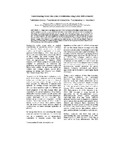| dc.contributor.author | Otiti, T. | |
| dc.contributor.author | Ekosse, G-I. | |
| dc.contributor.author | Stephen, S.T. | |
| dc.date.accessioned | 2009-07-16T11:51:55Z | |
| dc.date.available | 2009-07-16T11:51:55Z | |
| dc.date.issued | 2007-06 | |
| dc.identifier.citation | Thomas, O. et al (2007) Understanding nickel thin film crystallization using x-ray diffractometry, Journal of Applied Sciences and Environmental Management, Vol. 11 (2), pp. 57-60 | en_US |
| dc.identifier.issn | 1119-8362 | |
| dc.identifier.uri | http://hdl.handle.net/10311/353 | |
| dc.description.abstract | Normal, helical and zigzag deposited Ni films were produced by letting a vapour stream of source
material impinge on Corning 1737 glass substrates at oblique incidence while rotating the substrate during deposition.
Films produced by glancing angle deposition (GLAD) technique while rotating the substrate. The microstructures of
these Ni films were studied using X-ray diffractometry technique. The X-ray diffraction (XRD) patterns depicted 100%
and 42% relative intensity (RI) peaks identified for normal and helical deposited Ni films but none for the zigzag
deposited Ni film. Higher degree of crystallinity of Ni was demonstrated by the helical thin film sample having 200 nm
thickness (sample Ni40) compared to the normal thin film which had only the 100% RI peak defined. Should an
application therefore require Ni thin films of high crystallinity, it would be the film prepared with helical microstructure
of 200 nm thickness that will be employed. | en_US |
| dc.language.iso | en | en_US |
| dc.publisher | Bioline International. http://www.ajol.info/journal_index.php?jid=90 | en_US |
| dc.subject | Nickle Thin Film | en_US |
| dc.subject | Crystallization | en_US |
| dc.subject | X-Ray Diffractometry | en_US |
| dc.title | Understanding Nickel Thin Film crystallization using X-Ray Diffractometry | en_US |
| dc.type | Published Article | en_US |

